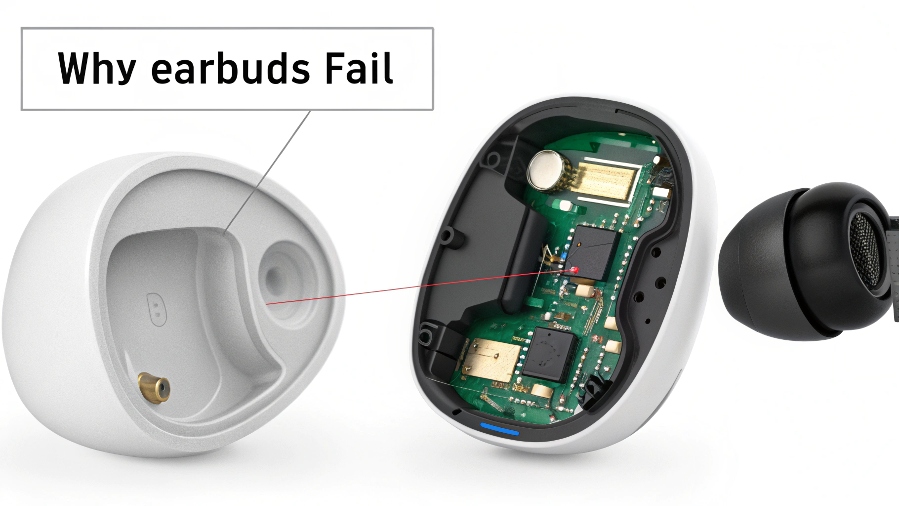Is there anything more frustrating than your wireless earbuds dying mid-song1 or call? You charged them, but the battery just gives up. Let's fix this common headache.
Earbuds that won't stay charged usually suffer from an aging battery2, dirty charging contacts3, or improper charging habits4. Start by cleaning the contacts, resetting the earbuds, and adopting better charging routines. If these fail, the battery itself may need replacement.
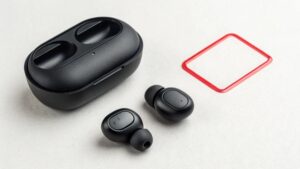
As someone who has manufactured audio products for years, I've seen every possible reason for battery failure. It's one of the most common complaints I hear. The good news is that many of these issues are preventable or fixable with a little know-how. Let's break down the problems and solutions one by one so you can get back to enjoying your music without interruption.
How do I fix my earbuds battery draining fast?
You start your day with 100% battery, but it plummets to zero in no time. This rapid drain makes your earbuds feel unreliable and useless.
To fix a fast-draining battery5, try a full charge-discharge cycle6, reset the earbuds, and clean the charging points on both the earbuds and the case. Also, disabling features like Active Noise Cancellation (ANC)7 and high-volume playback can significantly extend usage time.
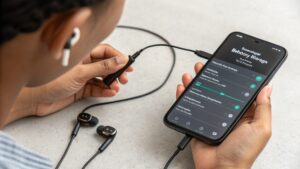
When customers brought products with fast-draining batteries to my old trading company, we always followed a checklist. For an engineer like Jacky, this systematic approach will make sense. Before you assume the battery is dead, you need to rule out software glitches8 and simple maintenance issues. These steps often solve the problem without costing you anything.
Quick Fixes to Try First
Here’s a simple checklist to work through. These actions can often restore your battery performance by fixing software bugs or connection issues that cause unnecessary power drain.
| Action | Why It Works |
|---|---|
| Perform a Full Cycle | Let the earbuds and case drain to 0%, then charge them together to 100% without interruption. This helps recalibrate the battery's software and can fix inaccurate percentage readings. |
| Clean the Contacts | Use a cotton swab and a little isopropyl alcohol to gently clean the metal charging points on your earbuds and the pins inside the case. Dirt and oil can prevent a solid connection, leading to incomplete charging. |
| Reset the Earbuds | Follow the manufacturer's instructions to perform a factory reset. This clears out any software bugs that might be causing the processor to work overtime and drain power. |
| Update Firmware | Check the companion app for any firmware updates9. Manufacturers often release updates that include improvements to power management and efficiency. |
Why are my earbuds not staying charged?
You store your earbuds in the case, expecting a full charge, but they're dead when you need them. It feels like they're losing power even when not in use.
This is often a sign of a deeper hardware problem. The battery has likely degraded, or you are using a cheap, poorly made product. In my experience, batteries in no-name earbuds fail much faster because they lack essential safety features.
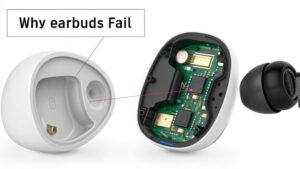
This is where my manufacturing background gives me a crucial perspective. I want to share two insider secrets. First, never let your earbuds sit dead for a long time. The lithium-ion battery's voltage can drop below its safety threshold (around 3.7V), triggering a protection mode that can make it difficult or impossible to recharge. Always try to store them with at least a partial charge.
Second, and this is very important, avoid ultra-cheap, no-brand earbuds. From a production standpoint, the biggest cost-cutting measure is on the battery and its protection circuit. A quality product has a protection board to prevent overcharging and short circuits. Cheap ones often don't. This not only leads to a short lifespan but also creates risks like battery swelling10 or, in rare, extreme cases, fire. Paying a little more for a reputable brand is an investment in safety and reliability.
Why do my earbuds keep disconnecting at full battery?
Your earbuds show 100% charge, yet they keep cutting out. This technical mystery can be maddening, especially when you know the battery isn't the issue.
Disconnections at full battery are almost always a Bluetooth connectivity issue11, not a power problem. This can be caused by signal interference12, a software glitch between your phone and earbuds, or outdated firmware.
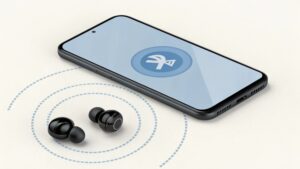
I’ve had to troubleshoot this exact problem for clients. It’s confusing because we instinctively blame the battery for any earbud malfunction. However, if the earbuds are powering on and reporting a full charge, the problem lies in the wireless link. Think of it like a perfect radio that keeps losing the station—the power is fine, but the signal is weak or interrupted.
Common Causes of Bluetooth Disconnects
Here are the usual culprits and how to address them:
- Signal Interference: Your Bluetooth operates on a crowded frequency (2.4 GHz). Wi-Fi routers, microwaves, and even other Bluetooth devices can interfere. Try moving away from other electronics to see if the connection stabilizes.
- Software Glitch: The simplest fix is often the most effective. Go into your phone’s Bluetooth settings, "Forget This Device," and then re-pair your earbuds from scratch. This clears any corrupted connection data.
- Distance and Obstacles: Bluetooth has a limited range, typically around 30 feet (10 meters) with a clear line of sight. Walls, and even your own body, can block the signal and cause dropouts. Keep your phone and earbuds close.
Why are my wireless headphones losing battery so fast?
Your big, over-ear headphones are also dying too quickly. While the principles are similar to earbuds, the scale of power consumption is different and worth understanding.
Headphones lose battery fast due to powerful features like large audio drivers, high-performance Active Noise Cancellation (ANC), and high-resolution audio codecs13. These features simply require more energy to run compared to smaller earbuds.
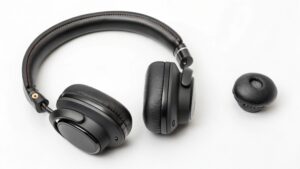
In the factory, we design these products with much larger batteries specifically to handle their higher power demands. However, user habits can still drain that larger battery in a hurry. For example, listening at maximum volume requires exponentially more power than listening at 50%. The same is true for ANC; the more background noise the headphone’s microphone has to process and cancel, the more power it consumes.
Headphone Power Consumption Factors
| Feature | Impact on Battery | Why |
|---|---|---|
| High Volume | High | Larger audio drivers in headphones need more electrical power to move and produce loud sound, draining the battery faster. |
| Active Noise Cancellation (ANC) | High | The microphones and processors that cancel external noise are always on and working hard, which is a major power drain. |
| High-Res Codecs (e.g., LDAC) | Medium | Transmitting more data for higher-quality audio requires more processing power from both your phone and headphones, increasing battery use. |
| Battery Age | High | Just like with earbuds, a headphone's battery capacity will naturally decrease over time after hundreds of charge cycles. This is unavoidable. |
Conclusion
Fixing battery issues involves good habits, simple maintenance, and choosing quality products. By understanding the cause, you can extend your earbuds' life and enjoy your music much longer.
-
Explore this link to understand the common reasons behind wireless earbuds dying unexpectedly. ↩
-
Learn about the impact of aging batteries on performance and how to mitigate issues. ↩
-
Discover effective cleaning methods to ensure your earbuds charge properly. ↩
-
Find out how to charge your earbuds correctly to prolong their lifespan. ↩
-
Understand the factors that lead to rapid battery drain and how to fix them. ↩
-
Learn the steps to recalibrate your earbuds' battery for better performance. ↩
-
Explore the relationship between ANC features and battery consumption. ↩
-
Get tips on troubleshooting software issues that may affect your earbuds. ↩
-
Stay updated on the latest firmware to enhance your earbuds' performance. ↩
-
Understand the risks of battery swelling and how to prevent it. ↩
-
Learn about common Bluetooth problems and how to resolve them effectively. ↩
-
Discover how to minimize signal interference for a stable connection. ↩
-
Learn how audio codecs can influence your headphones' power consumption. ↩

